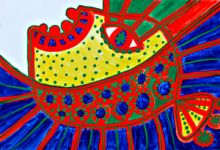History of arts knows thousands of examples when the one that feels the world in a special way and has a gift of reproducing it visually achieves success sooner than the one with formal education and a university degree. This is the story of Yulia Hushul – she graduated with a degree in information technology, but has not worked a single day in that field.
Hushul was born into a family of artists, she always wanted to paint. But after graduating from high school she applied to study at the information technology department at the Kyiv Mohyla Academy. The real “wave” of inspired creativity arose in the artist’s soul thanks to... social networks. Hushul signed up on Facebook and uploaded her drawings on her personal page. On the same day the Kyiv Museum wrote her that they liked her works immensely. In literally a year the artist went through numerous stages of art: she painted with acrylic colors on clothes, leather bands, and then canvas. Later on she learned to paint on glass with vitrage colors.
“A clear understanding that painting is my thing dawned on me five years ago when I met my future husband. He gave me gouache paints and brushes as a present and said: “Go ahead and draw,” says Hushul. “And he did this because he was fond of Osho philosophy and attended creativity classes. I started drawing and quickly realized that I had finally found my calling! I did not draw before because I was stopped by a thought that I am not talented or do not possess enough imagination for that. But when I started drawing, it turned out that colorful and kind images live inside of me.”
Now you create dolls, how did you come to this?
“I started sewing dolls a couple of weeks before I started drawing. I had dreamt of creating dolls for a long time, but in this case I was afraid of messing up the fabric. Once I decided to throw away an old dress and thought, if I was going to get rid of it anyway, it would be no harm if I give it a try. That is when I cut my first doll out. I took it to the Afisha office where I was working as an editor at that time, and everybody liked it. After work I sewed another one, showed it to the Afisha staff again. And for the whole week I brought new dolls to the office. I have not stopped making them. It feels so nice, knowing that it was just a piece of unecessary fabric or an old shirt – and voila, then it is someone who can look at you with button eyes. This feeling is hard to render!”
All works by Hushul are full of color and joy, they are alive. The reason for that is probably because she was born in the Carpathians, the village of Vyzhnytsia, Chernivtsi oblast, and she grew up surrounded with Hutsul embroidery during her childhood. As a kid, she used to spend a lot of time at her grandmother’s, an embroidery artist. She copied the ornaments with felt pens and water-colors, looked through the albums with patterns hundreds of times, and made her own embroideries. Hutsul embroideries are known for such bright, saturated reds, greens, oranges, yellows, blues, and blacks. It is a tradition in the Carpatians to use these colors, so the embroidered shirt can be seen from very far, because your closest neighbour could live on the nearby mountain.







